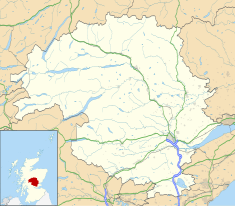
Perth is a city in central Scotland, on the banks of the River Tay. It is the administrative centre of Perth and Kinross council area and the historic county town of Perthshire. It had a population of about 47,430 in 2018.

Aberdalgie is a small village in the Scottish council area of Perth and Kinross. It is 3 miles southwest of Perth, and lies between the B9112 road, to the north, and the River Earn, to the south. Milltown Burn and Cotton Burn streams meet in the village centre, The village contains Aberdalgie Parish Church, the present building of which dates to 1773. The historic Dupplin Castle is 1+1⁄2 miles east of the village.
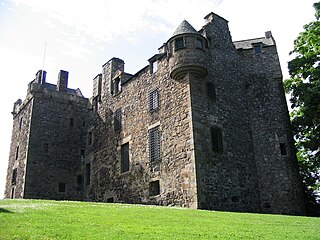
Elcho Castle is located close to the south bank of the River Tay approximately four miles south-east of Perth, Scotland, in the region of Perth and Kinross. It was the maintained by Clan Wemyss from its construction around 1560 until it was put into the care of the Secretary of State for Scotland in the early 20th century, though was not occupied for the entire time. In around 1830 it was re-roofed and a nearby cottage constructed. The castle has been a scheduled monument since 1920 on the grounds of being "a particularly fine example of a Medieval tower-house", and the cottage became a listed building in 1971 in recognition of it's national importance. The castle is unusual in that it has both en suite guest accomodation like a mansion, but also a large number of gun loops.
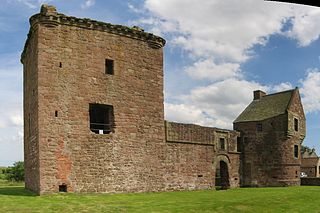
The remains of Burleigh Castle are located just outside the village of Milnathort, 1.5 miles north of Kinross, in Perth and Kinross, Scotland. The castle dates from the 15th and 16th centuries, and now sits beside the A911 road, opposite a 19th-century steading, recently adapted into housing.

Fingask Castle is a country house in Perth and Kinross, Scotland. It is perched 200 feet (61 m) above Rait, three miles (5 km) north-east of Errol, in the Braes of the Carse, on the fringes of the Sidlaw Hills. Thus it overlooks both the Carse of Gowrie and the Firth of Tay and beyond into the Kingdom of Fife. The name derives from Gaelic fionn-gasg: a white or light-coloured appendage.

Ochtertyre is a country house and estate in Perth and Kinross, Scotland. It is located in Strathearn, between Crieff and Loch Turret, north of the A85.
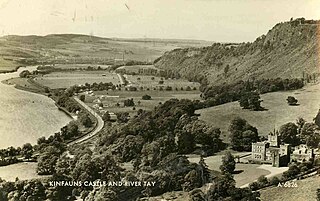
Kinfauns Castle is a 19th-century castle in the Scottish village of Kinfauns, Perth and Kinross. It is in the Castellated Gothic style, with a slight asymmetry typical of Scottish Georgian. It stands on a raised terrace facing south over the River Tay. The house is protected as a category A listed building, and the grounds are included in the Inventory of Gardens and Designed Landscapes in Scotland.

Monzievaird is a place in Scotland, situated 2 miles (3 km) west of Crieff in Highland District of Perth and Kinross. The village of Monzie; is a couple of miles to the east-northeast.
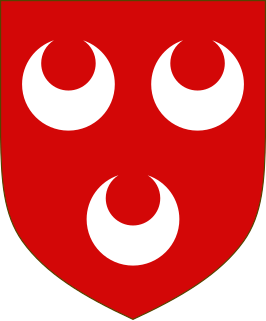
Sir William Oliphant, Lord of Aberdalgie and Dupplin, was a Scottish magnate, knight and leader during the Wars of Scottish Independence.

Rhynd is a hamlet in Perth and Kinross, Scotland. It is located 3+1⁄4 miles southeast of Perth, on the south side of the River Tay.

Tullibardine is a location in Perth and Kinross, Scotland, which gives its name to a village, a castle, and a grant of nobility.
Ardblair Castle is an L-plan castle, dating from the 16th century, around 0.75 miles (1.21 km) west of Blairgowrie in Perth and Kinross, Scotland.

Harold Ogle Tarbolton FRIBA (1869–1947) was a 19th/20th century British architect, mainly working in Scotland. He was affectionately known as Tarrybreeks. In later life he went into partnership with Sir Matthew Ochterlony to create Tarbolton & Ochterlony.

Bridgend is a residential area of Perth, Scotland, approximately 0.25 miles (0.40 km) east of the city centre, on the eastern banks of the River Tay. It is in Kinnoull parish. A settlement has existed here since at least the 16th century.

Dowhill Castle is a ruined castle in Perth and Kinross, Scotland. Sited on a hill near Loch Leven, the oldest part of the castle was built in around 1500 as a tower house. The main structure was extended in around 1600 with additional living space, as well as a tower and turret. The castle had a fortified courtyard (barmkin) to the north with a separate tower. There were probably four storeys but only two still survive.

St John's Kirk is a church in the Scottish city of Perth, Perth and Kinross. Of Church of Scotland denomination, it is located in St John's Place, just southeast of the city centre. It stands on the former site of a church dating to 1126. Today's structure, built around 1448, is a Category A listed building. The church is most noted for being the site of John Knox's 1559 sermon against idolatry, which began the Scottish Reformation.

The vennels of Perth are a collection of small medieval streets in the city of Perth, Scotland. Similar to York's Snickelways, vennels are a public right-of-way passageway between the gables of buildings which can, in effect, be a minor street. In Scotland, the term originated in royal burghs created in the twelfth century, the word deriving from the Old French word venelle meaning "alley" or "lane". Unlike a tenement entry to private property, known as a "close", a vennel was a public way leading from a typical high street to the open ground beyond the burgage plots. The Latin form is venella, related to the English word "funnel".

Tullibardine Chapel is an ancient church building in Tullibardine, Perth and Kinross, Scotland. It is one of the most complete medieval churches in Scotland. A large part of it dating to 1446, it is now a scheduled monument.
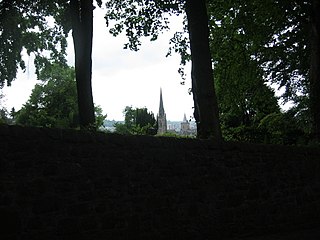
Kinnoull Terrace is a street in the Kinnoull parish of Perth, Scotland. A cul-de-sac, it contains five properties, each of which is of listed status and dating from the 19th century. The street was designed specifically, in the mid-19th century, to take advantage of its viewpoint across the River Tay, as was the case with the six villas in Bridgend, a few hundred yards to the north. Noted architectural historian Charles McKean observed that those with "money of the [19th] century jostled for prime sites and views on Dundee Road and Kinnoull Terrace".

